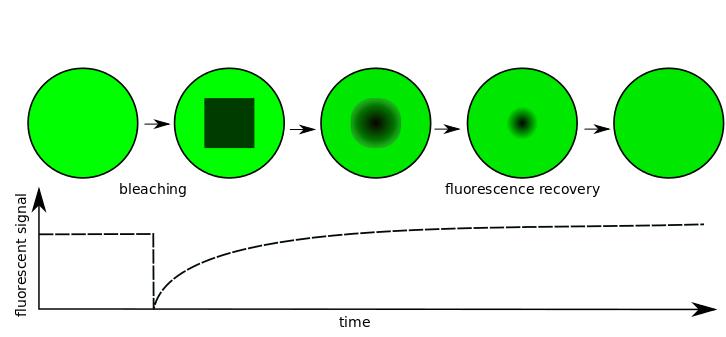One step closer to reality

In FRAP assays, the time that fluorescent molecules need to replenish a bleached-out area is measured, basically assessing how quickly a dark sample area turns bright again. © Alexander Bläßle, FML
In FRAP assays (FRAP: Fluorescence Recovery After Photobleaching), the time that fluorescent molecules need to replenish a bleached-out area is measured, basically assessing how quickly a dark sample area turns bright again. However, the evaluation of the resulting microscope images is anything but trivial: Molecular movement depends, among other things, on the shape of the environment.
If a complex structure is approximated with oversimplified geometries to facilitate analysis, the estimated diffusion coefficients can be far off the actual values. PyFRAP operates without such simplistic assumptions and instead takes more realistic, three-dimensional structures into account. The program then numerically simulates the experiment and uses classical algorithms to fit the simulations to the measured data.
Dr. Alexander Bläßle, lead author of the publication, and his colleagues have identified a variety of potential problems with current FRAP analysis methods and addressed these during the development of PyFRAP. This thoroughness paid off: Compared to alternative programs, PyFRAP delivers particularly reliable results, especially under complicated conditions. And its flexible initial conditions also allow for evaluation of iFRAP data (iFRAP: inverse FRAP), a relatively new alternative to FRAP which is less harmful to delicate samples.
With the availability of a more precise analysis method, new applications for FRAP or iFRAP assays could now arise. The authors point out that their software can help to explore the interactions between molecules in living organisms: For example, it could help determine whether molecules are slowed down by interacting with (maybe so far undiscovered) binding partners.
PyFRAP has the potential to establish itself as a new standard analysis program in basic research. In any case, it already provides an impressive example of the benefits of constantly challenging established strategies and not being satisfied with simple, yet less accurate solutions.
Software: The PyFRAP program is available to download free of charge at the following links:
http://www.fml.tuebingen.mpg.de/mueller-group/software.html
https://mueller-lab.github.io/PyFRAP/
Original Publication: Bläßle A, Soh G, Braun T, Mörsdorf D, Preiß H, Jordan BM, Müller P (2018). Quantitative diffusion measurements using the open-source software PyFRAP. Nature Communications, DOI: 10.1038/s41467-018-03975-6.
Contact:
Dr. Patrick Müller
Max Planck Research Group “Systems biology of development”
Phone: 07071 601-815
Email: patrick.mueller@tuebingen.mpg.de
http://www.fml.tuebingen.mpg.de/mueller-group.html
About us
The Max Planck Society for the Advancement of Science in Germany consists of 83 research institutes. The Max Planck Campus in Tübingen employs more than 700 staff members and comprises the MPI for Developmental Biology, the MPI for Biological Cybernetics, the MPI for Intelligent Systems, and the Friedrich Miescher Laboratory.
The Friedrich Miescher Laboratory (FML) was founded in 1969 by the Max Planck Society. It provides outstanding young researchers the opportunity to establish a research group and an independent research program with generous support over a period of several years. Approximately 50 employees in four research groups currently work at the FML.
Software: The PyFRAP program is available to download free of charge at the following links:
http://www.fml.tuebingen.mpg.de/mueller-group/software.html
https://mueller-lab.github.io/PyFRAP/
Media Contact
More Information:
http://www.fml.mpg.deAll latest news from the category: Life Sciences and Chemistry
Articles and reports from the Life Sciences and chemistry area deal with applied and basic research into modern biology, chemistry and human medicine.
Valuable information can be found on a range of life sciences fields including bacteriology, biochemistry, bionics, bioinformatics, biophysics, biotechnology, genetics, geobotany, human biology, marine biology, microbiology, molecular biology, cellular biology, zoology, bioinorganic chemistry, microchemistry and environmental chemistry.
Newest articles

NASA: Mystery of life’s handedness deepens
The mystery of why life uses molecules with specific orientations has deepened with a NASA-funded discovery that RNA — a key molecule thought to have potentially held the instructions for…

What are the effects of historic lithium mining on water quality?
Study reveals low levels of common contaminants but high levels of other elements in waters associated with an abandoned lithium mine. Lithium ore and mining waste from a historic lithium…

Quantum-inspired design boosts efficiency of heat-to-electricity conversion
Rice engineers take unconventional route to improving thermophotovoltaic systems. Researchers at Rice University have found a new way to improve a key element of thermophotovoltaic (TPV) systems, which convert heat…



